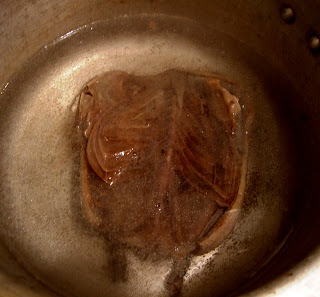My love affair with this echinoderm (that is the proper
taxonomic name) started way back in 2004 when I tasted it for the first
time. I had known of the sea urchin or
kina as the local Māori call it here in New Zealand, for a while, but I never had
the pleasure of trying one. In fact, back then, I did not even know that these
things were edible! Oh how naive and ignorant I was. More so to think that I
was missing out on what I now consider as one of the tastiest naturally
occurring foods out there.
The initial looks of this echinoderm does not do it proper
justice when you think of the heavenly delight that it holds within itself. It
is brown, spiny and in no way looks appetising in any sense. Yet once you crack
into it, those fat glistening orange roes that stare out at you, bring an
appreciative tear to all connoisseurs of this heavenly roe and leave their
mouths watering eager to savour the roe in all its delicious glory. Yes, I do
say connoisseurs as the taste of this roe is definitely something that is
acquired and is not everyone’s cup of tea. I have seen people that swear by it
and the first thing they devour if presented on a seafood platter or just
amongst other shell fish. While there
are those that stay as far as possible from it and would rather starve than eat
this roe if it was the last thing available to eat. Such is the relationship
between the kina and its purveyors that it can either leave you addicted in its
delicious embrace or repel in its hideous appearance.
I would rather not bore you with the taxonomy, physiology or
the anatomy of the kina and would suggest you Google it instead and read it in
your own leisure. I however, will visually delight you about the delicious
qualities and nature of the kina. Well, at least in the context of my trip to
Santiago, Chile. Prior to coming to Santiago, I had in my mind to try out the
erizo after reading about it and especially to find out if there were any major
differences in taste between its sisters.
The Chilean sea urchin, erizo in Spanish is a sister of the New Zealand
kina. While they are not the same, they
are of the same family and are equally delicious in nature.
So 48 hours after I landed in Santiago and after satisfying
all other social commitments i.e. the wedding, I was free to go forth and
indulge in some serious two fisted gorging. Given that Chile is renowned for
its seafood; there was only one way I was going to get myself a proper sample –
the fish market. First on my list – erizo and where better to sample one than the
Mercado Central; Santiago’s very own seafood market. The signs couldn’t have
been more ominous. Walking into the market, and at the first seafood vendor I
see, these little beauties lay arranged on the counter in a way that could only
be described as flirting visually, enticing you to come and try it and remain
mesmerised in the thought that you had just consumed seafood mana.
My mind at this point was on the verge of serious overload
anticipating the kina and behaviour that could only be likened to an addict
waiting to get another hit. What happens next is exactly what happened to me in
that market. I let my senses take over rather than the brain and let it guide
me through the experience.
A picture speaks a thousand words the saying goes and I finally
found this to be true to the last letter. See, Enjoy, Revel. I know I did and I can confirm, the love affair still continues…





















